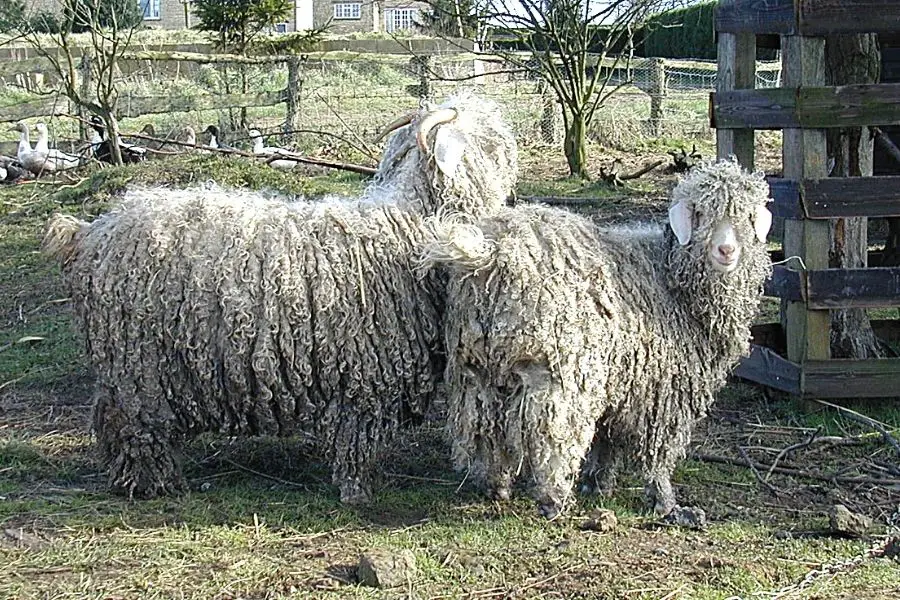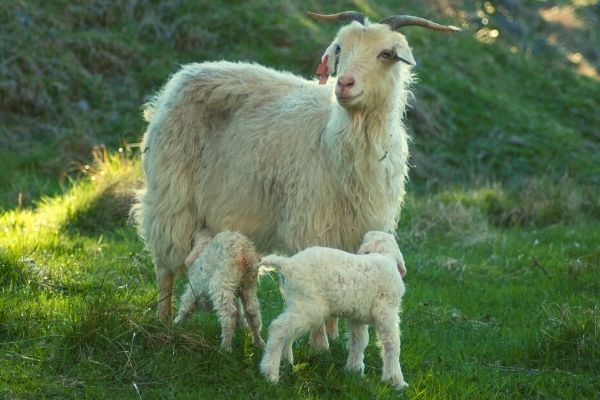Goats, just like cows and other cattle, grant us a wide array of goods according to what they excel at naturally. Some are excellent milk producers, while others are generally raised for their superb meat or skin. Angora goats deliver mohair, a kind of textile fiber used extensively in Turkey and imported to Europe in the 19th century.
But, can Angora goats be used as dairy goats?
Angora goats are not known for being great milk producers. As a matter of fact, they struggle to produce enough milk for kids' sustenance, needing special treatment and nutrition to optimize teat performance. The milk itself has low nutritional value.
Lets find out some interesting facts about angora goat breed.
What Are Angora Goats?

As its name might suggest, the Angora goat originated as a domestic breed around the district of Angora (or Ankara), in what nowadays is the northwestern portion of Turkey.
It is posited that these small animals have been raised in the region since at least the 5th century BC (although some would point to even earlier dates) and were not recorded to be bred outside these boundaries until relatively recent times
The first known instance of Angora goat imports into Western Europe dates from 1531 (almost a century after the Ottoman siege of Constantinople). It was the Dutch Ambassador who bought two of these, at a time when their exportation was, for the most part, strictly forbidden, although these prohibitions would be intermittent.
However, the first major recorded export of Angora goats was made in the 19th century. It was a gift Sultan Abdulmecit made to Queen Victoria, consisting of 22 specimens.
They were also beginning to be exported to South Africa around 1838 in a successful attempt to create a profitable Angora goat industry in the area. South Africa has stood as a major producer and exporter of mohair in recent years due to their exponential development of Angora goat farming.
Angora goats are distinctively smaller than most other breeds of goats and sheep, measuring around 55 cm. Their mohair is abundant, fair, lustrous, and smooth, distinguishing these creatures from most other goat breeds with thick fleece. They're regularly sheared twice a year and produce copious amounts of yarns for major textile corporations.
Are Angora Goats Good Milkers?
As explained before, Angora goats are fiber goats.
Angora goats are not good milkers as they cannot produce enough milk to get them added to the "dairy goats" category.
The textile industry, however, has made extensive use of their fleece, at times even compared to sheep wool but silkier, shinier, and more elastic, favored for luxury clothing.
Angora goats can yield an enormous amount of yarn, equivalent to approximately 25% of their body weight, and are deemed as one of the most efficient fiber suppliers worldwide.
Is Angora Goat Good for Meat?
Despite their hefty appearance, Angora Goats meat quota is simply not enough to compensate for the revenue that their mohair production entails. They don't suffer the same fate as other meat yielders, such as the South African Boer or the Bangladeshi Black Bengal.
That is not to say that they can't provide good-quality meat, but you'll have to pay a sizable sum to cover the producer's losses.
Skinning an Angora goat is awfully tricky, considering their thick skin which represents around 15% of the body weight.
Are Angora Goats Friendly?
Angora goats are extremely friendly, kind, and gentle. It's a joy being around them as they're not aggressive in the slightest. Just don't mess with the kids! Angora mothers tend to be very jealous of their offspring, which may be surprising considering how little they can cater to them in terms of food provision.

Angora doe with kids
They are not prone to flee from the herd, but they're overly curious (as in, they like to tread in forbidden or unexplored terrains), which is why it's still crucial to fence them in.
Are Angora Goats Easy to Raise?
Angora goats are not extraordinarily expensive to raise. Still, they will need more onerous meals in order to grow optimal hair for yarn. However, they are content eating poor-quality bushes and shrubs for the most part. They tend to be on pasture all summer long and on a hay diet throughout the winter months.
Some suggested additions Angora goats' dietary regime include alfalfa hay, black oil sunflower seeds, and specialized goat feed rich in protein, coupled with baking soda for better digestion.
Do Angora Goats Need Shearing?
Angora goat grow short of an inch of hair per month, so shearing on a semestral basis should give you around six inches of yarn. It's ideal not to let the hair grow much longer than that, for it gets too twirly and, hence, difficult to handle, especially if we speak of adult goats with hair as thick as over 33 microns.
Shearing should not be done in the colder months, for Angoras are not very resistant to low temperatures when fleeceless, unlike most other breeds. If shearing is done during the winter season, they ought to be sheltered.
When fleeced, they can withstand temperatures, but not the rain. Suppose they're exposed to rainwater under chilly weather. In that case, the cold water will fill the fleece and potentially lead them to suffer from pneumonia.
Finally, Angora goats should be subjected to fierce parasite control and should be dewormed more often than many other breeds. Their fleece is also susceptible to annoying lice infestation, which, apart from being detrimental to the goat's health, is counterproductive for fleece quality.
Also Read: How to Trim a Dairy Goat for Show
What are the Peak Breeding Periods for Angora Goats?
Angoras tend to show heat around the fall, similar to other goats, with a gestation period hovering around the area of 150 days. The period of peak ovulating activity is during April-May in South Africa (which is its Autumn season) and October-November in the northern hemisphere.
Sources:
Angora Goat - an overview | ScienceDirect Topics
Milk production by the Angora Ewe
